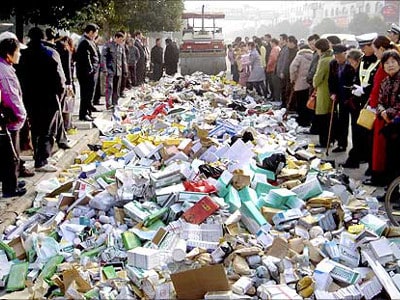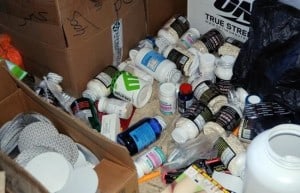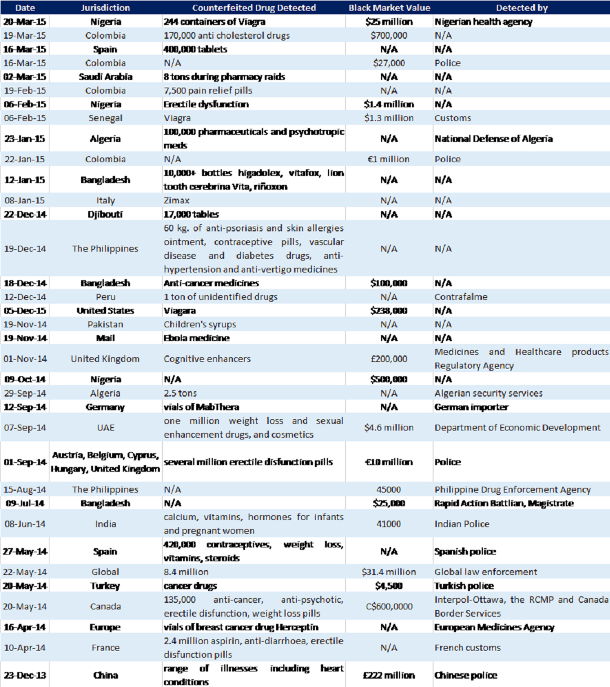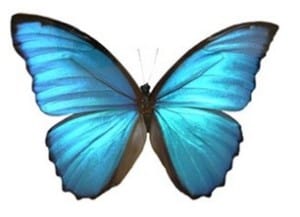
 This report was adapted by Cantech Letter from a piece prepared by Sophic Capital. For the original report, and more in-depth research, please visit Sophic Capital’s website, here.
This report was adapted by Cantech Letter from a piece prepared by Sophic Capital. For the original report, and more in-depth research, please visit Sophic Capital’s website, here.
The counterfeit pharmaceutical industry could be worth as much as $200 billion annually, which is slightly less than the $246 billion illicit drug trade. Criminal organizations are largely behind these counterfeit operations which could cause one million people to die this year. Nanotech Security, a Sophic Capital client, has a solution successfully deployed in the banknote industry which is portable to prescription pills. The technology is called KolourOptik, and it is a low cost, end-user engaging, near impossible to duplicate anti-counterfeiting technology that can be created on almost any surface including pharmaceutical pills.
Introduction
We were shocked to discover that fake pharmaceutical drugs are the largest, global counterfeit market. As detailed in our initial counterfeit goods report, COUNTERFEITING: An Industry 3 Times Larger than the Illicit Global Drug Trade, about $200 billion of fake pharmaceutical drugs are sold annually. To put this number into perspective, the global illegal drug trade is estimated at $246 billion. Fake pharmaceutical drug margins are high, luring criminal organizations who have little to fear from the lack of anti-counterfeiting laws and enforcement of existing laws.
So what; no one gets hurt. Not true. Counterfeit pharmaceuticals harm individuals, businesses, and shareholders. Fake pills are often made under unsanitary conditions using toxic materials; counterfeiters sometimes dilute dosages as in the case of Herceptin (Roche’s breast cancer treatment); counterfeiters exploit children and migrants at slave wages; counterfeiters don’t pay taxes, so guess who that responsibility falls upon? You. Counterfeiters steal corporate profits which harms employees, shareholders, and pension funds.

Sadly, people will die from counterfeit drugs. Interpol estimates that 10% to 30% of all pharmaceutical drugs in circulation in the world are counterfeit and that up to 1 million people will die annually from counterfeit pharmaceuticals. So, it’s time to end the myth that counterfeiting is a victimless crime – especially in the fake pharmaceutical drug trade.
Given the lack of laws and the weak enforcement of existing laws, the onus to curb the counterfeit drug trade falls upon the pharmaceutical companies. Unscrupulous counterfeiters are stealing these companies’ IP, sullying these companies’ brands, and placing peoples’ lives in mortal danger. But there is a solution that can help pharmaceutical companies to protect their customers and shareholders.
Nanotech Security (NTS:TSXV), a Sophic Capital client, offers a simple technology that counterfeiters cannot copy; an eye-catching technology near impossible to duplicate that, with a little consumer education, will (not “might”) protect customers from consuming dangerous imitation drugs. We will detail how pharmaceuticals can implement this inexpensive technology and how easily they can educate consumers to identify genuine products.
Note: Be careful when ordering prescriptions online. The World Health Organization estimates that over half of online pharmaceutical vendors are selling counterfeit drugs. Be especially careful of company websites stating they are “Canadian” because the FDA found 85% of the drugs being promoted as “Canadian” came from 27 other countries, and many products were counterfeit.
Counterfeit Drugs are Everywhere
“The trade in fraudulent medicines and medical devices, which now involves so many different products be they lifestyle and/or lifesaving medicines or products, is without doubt a global problem presenting a significant public health risk. No region or country is immune from this problem. Apart from the very real direct dangers presented by the consumption of fraudulent medicines or use of fake medical devices there is also evidence showing that the trade in such products has over time become an important source of income for organized crime groupings – be they informal networks or the more traditional organized crime groups.”
Aodhán Ó Ríordáin – Minister of State at Ireland’s Department of Justice and Equality

The number of pharmaceutical drugs, or new molecular entities (NMEs), approved in the United States is surprisingly few. From 1827 through the end of 2013, only 1,453 drugs were approved. Although we don’t know what the cost of developing a drug was in 1827, one estimate pegs today’s cost could be as much as $2.6 billion. With development and opportunity costs in the billions, it’s no wonder pharmaceutical companies are concerned about abating the global counterfeit drug trade. Law authorities are making progress (Exhibit 1,) but these seizures are miniscule compared to the broader $200 billion market for counterfeit drugs.
Counterfeit drugs have plague Nigeria in recent years. A survey of Nigerians found that about 20% believe they are victims of the counterfeit pharmaceutical industry. Twenty-nine percent of those who believed they consumed counterfeits said their opinion came from adverse reactions to the drugs. Thirty-five percent had no health improvements, and twenty three percent became suspicious because of the packaging. Only 7% accessed a government health website to verify whether or not the pills were real. Only 1% reported the fake drugs to authorities, 5% did not know what to do, 33% took no action, and 62% returned the counterfeits. To us, a more overt method of identification would aid consumers, both those who suspected counterfeit drugs and those who may have ingested them unknowingly, and increase the 20% threshold of those who encounter fake drugs.
France sees increased fake drug seizures. In 2014, French authorities seized 8.8 million counterfeit articles (up 15.4% over 2013). Of these, 2.6 million (~30%) of these articles were counterfeit drugs. This was a 90% increase in the number of counterfeit drugs seized in 2013.
Criminal Organizations Love Counterfeit Drugs
“You can see the Mafia people saw the opportunity to make money and they know that pharmaceutical crime is one of the good havens for them right now because of lack of legislation and the complexities of coordination in countries.”
Aline Plancon – Head of Interpol’s pharmaceutical crime unit
Some Global Counterfeit Pharmaceutical Seizures

Limited resources to combat fake drugs. Enforcement agencies don’t have the budgets, the time, or the tough laws needed to combat not only fake drugs but also the counterfeit industry as a whole. Criminal organizations know this and are exploiting these deficiencies. Success is particularly easy in the developing world. Take Colombia and Venezuela, for example.

“Contraband drugs is a multi-million (dollar) business that affects thousands of lives and seems to have no end in sight.” So reads the sub-headline in an article about the counterfeit drug trade written by Colombia’s SEMANA magazine. The differences in health care systems in both countries has created a profitable opportunity for criminal gangs. Since 2003, Venezuela has placed price controls on drugs. As a result, Venezuela accumulated a $4 billion debt to the pharmaceutical companies which caused the pharmas to limit sales. Criminal gangs found Venezuelan doctors to write prescriptions then sold the lower cost drugs into Colombia’s higher priced free markets, many times, after diluting the original drugs. To fill the void left in Venezuela, gangs created counterfeit drugs, preying upon the hope of people who cannot afford or who cannot find their medications through the government. This created a health issue where upwards of 10% of the pharmaceutical drug supply in both countries is fake.
The problem of counterfeit pharmaceuticals is especially worrisome in Afghanistan. One government ministry estimates that that at least 50% of Afghanistan’s $700 to $880 million pharmaceutical import market is counterfeit. According to the Guardian, root causes include: corruption, an uncontrolled 1,600 mile border, the lack of registration for medical companies, and inadequacy of licensing standards.
Governments are Taking Action Against Counterfeit Drugs
U.S. Representative Steve Israel introduced legislation into the House of Representatives that increase the penalties for the sale or trade of counterfeit pharmaceuticals. The Counterfeit Drug Enforcement Act of 2014 increases the penalty from a maximum of ten years to life in prison. The bill also provides for recall authority should a drug constitute a public health risk.
The E.U. continues to build on its 2011 Falsified Medicines Directive. By the beginning of 2018, prescription and some over the counter drugs sold in the E.U. must comply, requiring pharmaceutical companies to overhaul their packaging, distribution systems, and tracking of all of their drugs. Medicines must have a unique serial number applied at the point of manufacture and tracked through a database. Some industry analysts believe that pharmaceutical companies will apply the serial number via 2D barcodes.
How Technology can Stem the Rise of Counterfeit Drugs
There are two types of technologies aimed at minimizing counterfeit drugs: tracking and authentication. Tracking involves the movement of drugs through the supply chain and typically involves barcodes or radio frequency identification (RFID) for validation. Authentication is for the end user. These consist of packaging holograms, optically variable devices (like holograms but without 3D effects), and colour shifting inks and micro-taggants on packaging or film-coated tablets.
Authentication technologies suffer from a major weakness. No amount of anti-counterfeiting technology will protect consumers unless they are educated about the product’s anti-counterfeiting measures. Allister McCullum, a former counterfeit expert at the European Central Bank, stated that counterfeiters “aren’t interested in producing near-perfect notes that will get past bank checking machines… They just aim for something that’s good enough to fool the general public.”
We believe pharmaceutical counterfeiters aren’t seeking perfection – only something that will fool consumers. Holograms can be duplicated, and unless a consumer knows what to look for, then she could be placing her life at risk with a counterfeit drug. Thus, the pharmaceutical companies need to educate consumers. This not only protects the patient but also the company’s intellectual property, brand, and profits. But with 1,453 FDA approved drugs in circulation, we don’t believe it’s realistic to expect pharmaceutical companies to launch 1,453 unique educational campaigns for doctors, pharmacists, and patients. What is needed is a general, unique technology that requires a single campaign.

Nanotech Security (NTS:TSXV), a Sophic Capital client, has the technology that pharmaceutical companies can launch a single campaign while engaging doctors, pharmacists, and patients. Nanotech Security’s technology is KolourOptik, a, nanotechnology solution based upon the optical properties of the blue morpho butterfly. KolourOptik creates a grid of nano-sized holes that replicate the interaction light has with this butterfly’s wings. The result is the creation of vibrantly-coloured images that appear similar to LEDs when illuminated.
Currently targeting the banknote industry, KolourOptik can be applied to a variety of surfaces including pills and any type of packaging. There is no additional need for dyes or pigments. Pharmaceutical companies can even embed data in the design thereby allowing all points in the supply chain to track and authenticate the drugs.
KolourOptik’s is nearly impossible to duplicate. Unlike holograms, which can be peeled off, KolourOptik images are embedded into the packaging.
KolourOptik’s eye-catching features engage end-users. Whether it’s on banknotes, liquor bottles, or pills, the key to a successful anti-counterfeiting technology is getting the end-user to engage. KolourOptik’s LED like vibrancy pops and draws the user to interact with it. Thus, we believe pharmaceutical companies would only have to issue one campaign, detailing the differences between traditional holograms and KolourOptik technology. It wouldn’t matter what image or text is embedded on pills since KolourOptik’s features are unique in anti-counterfeiting technology.
Conclusions
Counterfeit pharmaceuticals could kill upwards of one million people each year. Criminal organizations understand the high margins associated with counterfeit goods, and the lack of laws, enforcement of laws, and low chance of getting caught are incentives to continue endangering hundreds of millions of lives.
Nanotech Security, a Sophic Capital client, has a solution called KolourOptik that they’ve successfully deployed in the banknote industry. KolourOptik engages the end user, can track drugs through the supply chain, and is nearly impossible to duplicate thus making it a viable solution for pharmaceutical companies to protect their brand, their IP, and their shareholders’ interest.
Disclaimers
The particulars contained herein were obtained from sources that we believe to be reliable, but are not guaranteed by us and may be incomplete or inaccurate. The opinions expressed are based upon our analysis and interpretation of these particulars and are not to be construed as a solicitation of offer to buy or sell the securities mentioned herein. Sophic Capital Inc. (“Sophic Capital”) may act as financial advisor, fiscal agent or underwriter for certain of the companies mentioned herein, and may receive remuneration for its services. Sophic Capital and/or its principals, officers, directors, representatives, and associates may have a position in the securities mentioned herein and may make purchases and/or sales of these securities from time to time in the open market or otherwise. This report may not be reproduced in whole or in part, or further distributed or published or referred to in any manner whatsoever nor may the information, opinions or conclusions contained herein be referred to without in each case the prior written consent of Sophic Capital.
Leave a Reply
You must be logged in to post a comment.




 Share
Share Tweet
Tweet Share
Share




Comment